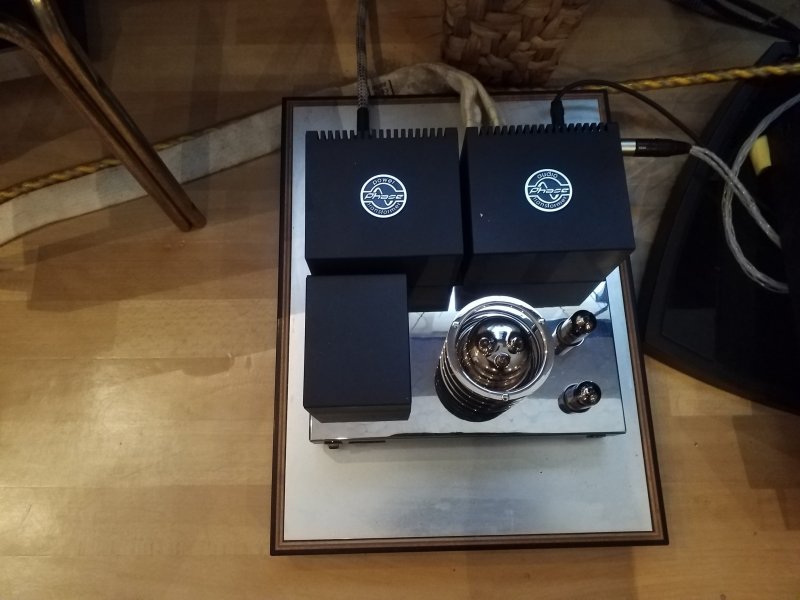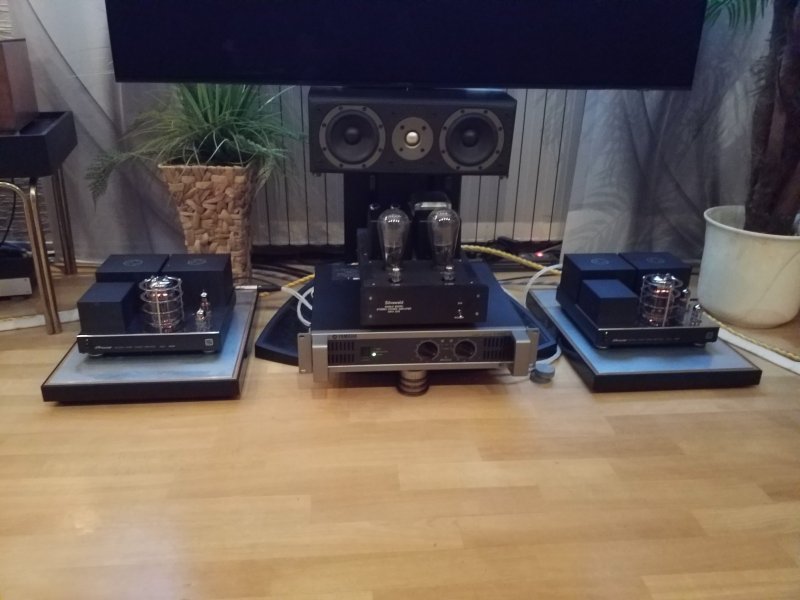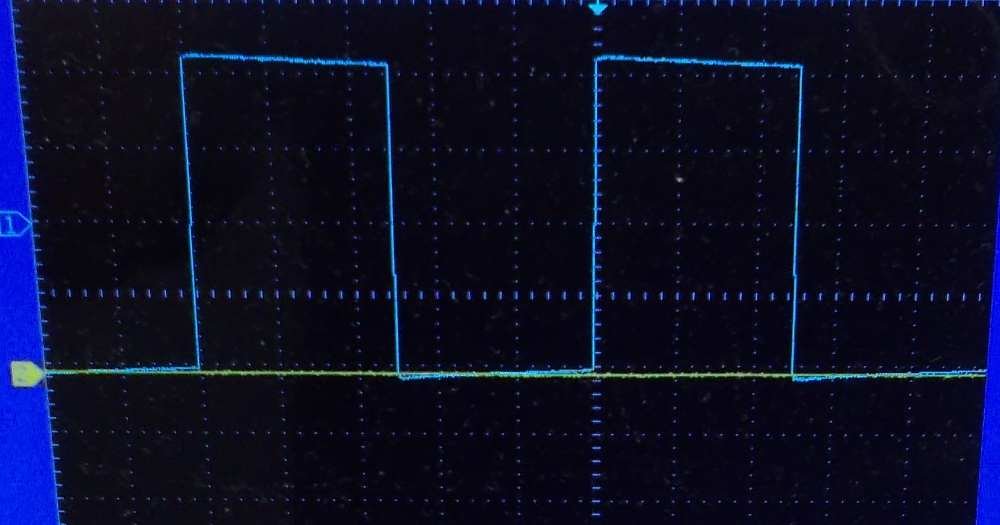I would rather have the better bass from SETs instead of SS, but just with appropriate speakers.But I'd be interested in hearing any amplifier that can reproduce SS bass tautness and SET transparency and sweetness.
SET amp owners thread
- Thread starter bonzo75
- Start date
You are using an out of date browser. It may not display this or other websites correctly.
You should upgrade or use an alternative browser.
You should upgrade or use an alternative browser.
Posting some pictures of the Silvercore 833MKIIs in the context of the room and system. The hORNS FP15s are a recent addition, moving up from the FP10s I got three years ago from Lukasz Domanski of Lukasz Audio Labs (LDMS). They were a huge jump and quite a different speaker to the FP10s which, although half the size, tended towards a heavier bass presentation, albeit one that was lacking control and fidelity. The FP15s go significantly lower, but they do so in a much more controlled and discrete way. I was worried that their size would over pressurise the room, but quite the opposite. If anything the FP10s were doing this and needed taming.
The FP15s sounded a touch bright but this has been solved by adding in a pair of Hivac NOS 12au7 tubes to preamp, replacing the Radio Technique 12au7s.
Full system context as follows:
LDMS MiniMax Server with upgraded power supply and cable
Lampizator Golden Gate MKI with KR Audio 5u4g rectifyer and 242 output tubes
Concert Fideliy CF080 LSX MKIII with Hivac 12au7 output tubes
Silvercore 833 MKII mono blocs in custom green hammerite finish
hORNS FP15s
Z-Axis Audio reference cables
High Fidelity CT-1 spekaer cablers
PAB isolation table and platform for electronics; Rogoz isolation stands for the power amps
Graphite Audio premium isolation cones under everything.
Boy and goat by Laura Panack ??
Man with psorisis by me
Interior decor by me
 Home by Greg Turner, on Flickr
Home by Greg Turner, on Flickr
 hORNS FP15s, Silvercore 833MKII by Greg Turner, on Flickr
hORNS FP15s, Silvercore 833MKII by Greg Turner, on Flickr
 hORNS FP15s, Silvercore 833MKII by Greg Turner, on Flickr
hORNS FP15s, Silvercore 833MKII by Greg Turner, on Flickr
 Home by Greg Turner, on Flickr
Home by Greg Turner, on Flickr
 Silvercore 833MKII by Greg Turner, on Flickr
Silvercore 833MKII by Greg Turner, on Flickr
 Silvercore 833MKII by Greg Turner, on Flickr
Silvercore 833MKII by Greg Turner, on Flickr
by Greg Turner, on Flickr
The FP15s sounded a touch bright but this has been solved by adding in a pair of Hivac NOS 12au7 tubes to preamp, replacing the Radio Technique 12au7s.
Full system context as follows:
LDMS MiniMax Server with upgraded power supply and cable
Lampizator Golden Gate MKI with KR Audio 5u4g rectifyer and 242 output tubes
Concert Fideliy CF080 LSX MKIII with Hivac 12au7 output tubes
Silvercore 833 MKII mono blocs in custom green hammerite finish
hORNS FP15s
Z-Axis Audio reference cables
High Fidelity CT-1 spekaer cablers
PAB isolation table and platform for electronics; Rogoz isolation stands for the power amps
Graphite Audio premium isolation cones under everything.
Boy and goat by Laura Panack ??
Man with psorisis by me
Interior decor by me
 Home by Greg Turner, on Flickr
Home by Greg Turner, on Flickr hORNS FP15s, Silvercore 833MKII by Greg Turner, on Flickr
hORNS FP15s, Silvercore 833MKII by Greg Turner, on Flickr hORNS FP15s, Silvercore 833MKII by Greg Turner, on Flickr
hORNS FP15s, Silvercore 833MKII by Greg Turner, on Flickr Home by Greg Turner, on Flickr
Home by Greg Turner, on Flickr Silvercore 833MKII by Greg Turner, on Flickr
Silvercore 833MKII by Greg Turner, on Flickr Silvercore 833MKII by Greg Turner, on Flickr
Silvercore 833MKII by Greg Turner, on Flickrby Greg Turner, on Flickr
Last edited:
Consider changing the KR rectifier in the Lampi. We tried the limited edition one in my Silvercore amp and greatly preferred NOS ones from Marconi and RCA. Much greater dimensionality and natural tone.Posting some pictures of the Silvercore 833MKIIs in the context of the room and system. The hORNS FP15s are a recent addition, moving up from the FP10s I got three years ago from Lukasz Domanski of Lukasz Audio Labs (LDMS). They were a huge jump and quite a different speaker to the FP10s which, although half the size, tended towards a heavier bass presentation, albeit one that was lacking control and fidelity. The FP15s go significantly lower, but they do so in a much more controlled and discrete way. I was worried that their size would over pressurise the room, but quite the opposite. If anything the FP10s were doing this and needed taming.
The FP15s sounded a touch bright but this has been solved by adding in a pair of Hivac NOS 12au7 tubes to preamp, replacing the Radio Technique 12au7s.
Full system context as follows:
LDMS MiniMax Server with upgraded power supply and cable
Lampizator Golden Gate MKI with KR Audio 5u4g rectifyer and 242 output tubes
Concert Fideliy CF080 LSX MKIII with Hivac 12au7 output tubes
Silvercore 833 MKII mono blocs in custom green hammerite finish
hORNS FP15s
Z-Axis Audio reference cables
High Fidelity CT-1 spekaer cablers
PAB isolation table and platform for electronics; Rogoz isolation stands for the power amps
Graphite Audio premium isolation cones under everything.
Boy and goat by Laura Panack ??
Man with psorisis by me
Interior decor by me
Home by Greg Turner, on Flickr
hORNS FP15s, Silvercore 833MKII by Greg Turner, on Flickr
hORNS FP15s, Silvercore 833MKII by Greg Turner, on Flickr
Home by Greg Turner, on Flickr
Silvercore 833MKII by Greg Turner, on Flickr
Silvercore 833MKII by Greg Turner, on Flickr
by Greg Turner, on Flickr
You mean you have a 5u4g rectifyer in your Silvercore? I'm guessing that's what you mean. The KR Audio one is supposed to be excellent but I have found somewhere with a big stash of NOS 5u5g rectifyers that aren't that expensive so may well give one a go.Consider changing the KR rectifier in the Lampi. We tried the limited edition one in my Silvercore amp and greatly preferred NOS ones from Marconi and RCA. Much greater dimensionality and natural tone.
Yes, I tried a lot of 5U4G, 5R4GY and 5AR4 rectifiers in my Silvercore. The best were a Marconi (Canada) 5U4G, RCA 5R4GY and a 1955 Valvo metal base GZ34 (5AR4). All of those types work in the Lampi I think (ask the Lampi guys to be sure).You mean you have a 5u4g rectifyer in your Silvercore? I'm guessing that's what you mean. The KR Audio one is supposed to be excellent but I have found somewhere with a big stash of NOS 5u5g rectifyers that aren't that expensive so may well give one a go.
I'm using a pair of DIY 300B PSET monoblocks and DIY planar-magnetic line-array dipoles.
This was my first tube DIY project, so I decided to start with a kit. I used the ANK 300B PSET Interstage C-Core monoblock kit, but only used parts of the kit - primarily the transformers and basic circuit design. Here's a partial list of the modifications:
Replaced the regulated DC supply for the 300B filaments with TentLabs DHT Filament supplies.
Added a regulated DC supply for the driver tube.
Used a regulated supply for the driver stage B+ (Maida regulator).
Added a soft-start (Neurochrome power controller).
Added a transformer-coupled balanced input.
Added a delayed-activation speaker relay to eliminate any turn-on thump or noise.
Replaced all resistors with AN 2W Silver Tantalums
Used solid silver in teflon hookup wire.
Added a first-order high-pass filtered input (as well as un-filtered input) to roll off the low frequencies.
Added an AC voltage divider across the OT primary to improve power supply rejection.
Replaced 300B tubes with matched new-issue Western Electric.
Designed a custom chassis with 6mm to 10mm aluminum panels.
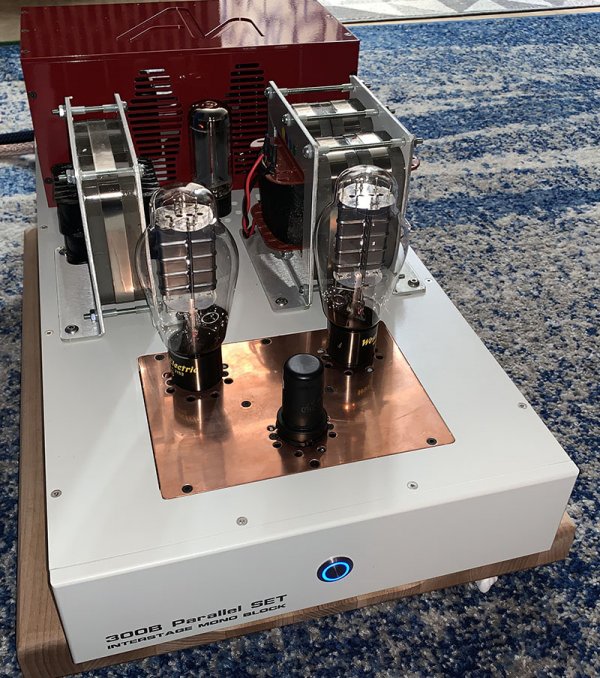
My speakers are based on GR-Research's Line Force with a pair of open-baffle servo woofer towers. The woofer towers each have four 12" servo woofers and are driven by Rythmik HX800 amps. Each of these amps has two Hypex 400W channels, so each channel handles two drivers. The woofers cover from the mid-teens up to about 180Hz, so my SET amp is only handling frequencies above this.
The Line Forces are two-way line arrays using six Bohlender-Graebener NEO10 drivers and sixteen NEO3 drivers for each channel. I had the cabinets made for me using a composite material since wood would not have been stiff enough with all the cutouts in the front baffle. I built the crossovers using copper foil inductors and Miflex copper foil caps. The Line Forces are about 98db/w, but as they are line arrays, SPL falls off at half the rate with distance as a point source speaker. My listening position is at approximately 4 meters, so this sensitivity is more comparable to a 104db/w point source speaker.
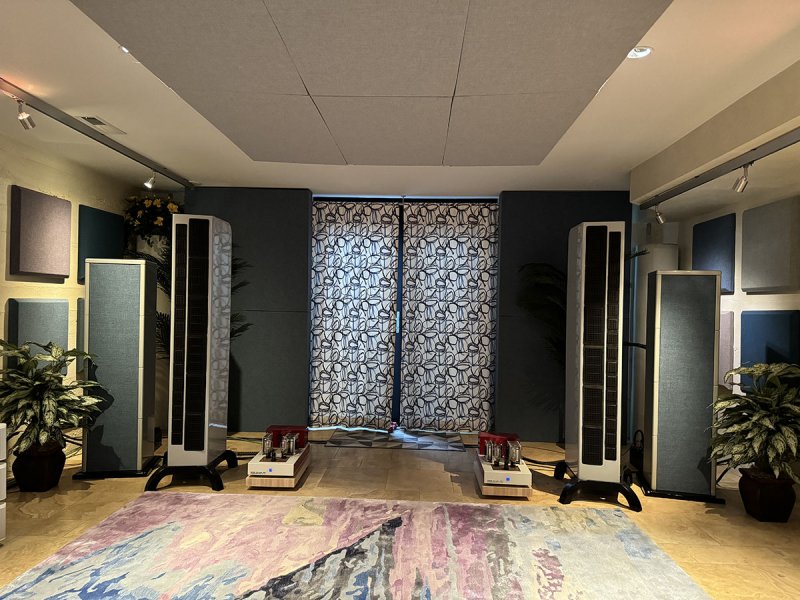
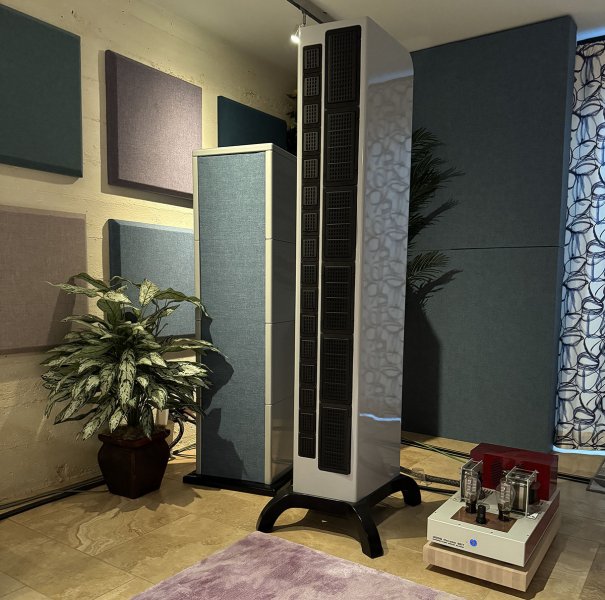
I have a nice pair of custom Monolith Magnetics output transformers waiting for my next SET amp build which will use a single 300B or 2A3. I think my speakers are plenty efficient to work well with lower power.
My current preamp is a two-chassis DIY balanced discrete solid state design with a balanced Khozmo relay-switched stepped attenuator. I am working on a couple new preamp builds, both of which are tube based.
My source is digital only - currently Sonore Signature Rendu SE into a Denafrips Gaia and Terminator Plus DAC.
This was my first tube DIY project, so I decided to start with a kit. I used the ANK 300B PSET Interstage C-Core monoblock kit, but only used parts of the kit - primarily the transformers and basic circuit design. Here's a partial list of the modifications:
Replaced the regulated DC supply for the 300B filaments with TentLabs DHT Filament supplies.
Added a regulated DC supply for the driver tube.
Used a regulated supply for the driver stage B+ (Maida regulator).
Added a soft-start (Neurochrome power controller).
Added a transformer-coupled balanced input.
Added a delayed-activation speaker relay to eliminate any turn-on thump or noise.
Replaced all resistors with AN 2W Silver Tantalums
Used solid silver in teflon hookup wire.
Added a first-order high-pass filtered input (as well as un-filtered input) to roll off the low frequencies.
Added an AC voltage divider across the OT primary to improve power supply rejection.
Replaced 300B tubes with matched new-issue Western Electric.
Designed a custom chassis with 6mm to 10mm aluminum panels.

My speakers are based on GR-Research's Line Force with a pair of open-baffle servo woofer towers. The woofer towers each have four 12" servo woofers and are driven by Rythmik HX800 amps. Each of these amps has two Hypex 400W channels, so each channel handles two drivers. The woofers cover from the mid-teens up to about 180Hz, so my SET amp is only handling frequencies above this.
The Line Forces are two-way line arrays using six Bohlender-Graebener NEO10 drivers and sixteen NEO3 drivers for each channel. I had the cabinets made for me using a composite material since wood would not have been stiff enough with all the cutouts in the front baffle. I built the crossovers using copper foil inductors and Miflex copper foil caps. The Line Forces are about 98db/w, but as they are line arrays, SPL falls off at half the rate with distance as a point source speaker. My listening position is at approximately 4 meters, so this sensitivity is more comparable to a 104db/w point source speaker.


I have a nice pair of custom Monolith Magnetics output transformers waiting for my next SET amp build which will use a single 300B or 2A3. I think my speakers are plenty efficient to work well with lower power.
My current preamp is a two-chassis DIY balanced discrete solid state design with a balanced Khozmo relay-switched stepped attenuator. I am working on a couple new preamp builds, both of which are tube based.
My source is digital only - currently Sonore Signature Rendu SE into a Denafrips Gaia and Terminator Plus DAC.
C
Congrats! Great builds all around!I'm using a pair of DIY 300B PSET monoblocks and DIY planar-magnetic line-array dipoles.
This was my first tube DIY project, so I decided to start with a kit. I used the ANK 300B PSET Interstage C-Core monoblock kit, but only used parts of the kit - primarily the transformers and basic circuit design. Here's a partial list of the modifications:
Replaced the regulated DC supply for the 300B filaments with TentLabs DHT Filament supplies.
Added a regulated DC supply for the driver tube.
Used a regulated supply for the driver stage B+ (Maida regulator).
Added a soft-start (Neurochrome power controller).
Added a transformer-coupled balanced input.
Added a delayed-activation speaker relay to eliminate any turn-on thump or noise.
Replaced all resistors with AN 2W Silver Tantalums
Used solid silver in teflon hookup wire.
Added a first-order high-pass filtered input (as well as un-filtered input) to roll off the low frequencies.
Added an AC voltage divider across the OT primary to improve power supply rejection.
Replaced 300B tubes with matched new-issue Western Electric.
Designed a custom chassis with 6mm to 10mm aluminum panels.
View attachment 118941
My speakers are based on GR-Research's Line Force with a pair of open-baffle servo woofer towers. The woofer towers each have four 12" servo woofers and are driven by Rythmik HX800 amps. Each of these amps has two Hypex 400W channels, so each channel handles two drivers. The woofers cover from the mid-teens up to about 180Hz, so my SET amp is only handling frequencies above this.
The Line Forces are two-way line arrays using six Bohlender-Graebener NEO10 drivers and sixteen NEO3 drivers for each channel. I had the cabinets made for me using a composite material since wood would not have been stiff enough with all the cutouts in the front baffle. I built the crossovers using copper foil inductors and Miflex copper foil caps. The Line Forces are about 98db/w, but as they are line arrays, SPL falls off at half the rate with distance as a point source speaker. My listening position is at approximately 4 meters, so this sensitivity is more comparable to a 104db/w point source speaker.
View attachment 118942
View attachment 118943
I have a nice pair of custom Monolith Magnetics output transformers waiting for my next SET amp build which will use a single 300B or 2A3. I think my speakers are plenty efficient to work well with lower power.
My current preamp is a two-chassis DIY balanced discrete solid state design with a balanced Khozmo relay-switched stepped attenuator. I am working on a couple new preamp builds, both of which are tube based.
My source is digital only - currently Sonore Signature Rendu SE into a Denafrips Gaia and Terminator Plus DAC.
Thank you. I checked out your audiogon system page. Looks like you've got some nice DIY builds as well. Nice work!C
Congrats! Great builds all around!
Nice!I'm using a pair of DIY 300B PSET monoblocks and DIY planar-magnetic line-array dipoles.
This was my first tube DIY project, so I decided to start with a kit. I used the ANK 300B PSET Interstage C-Core monoblock kit, but only used parts of the kit - primarily the transformers and basic circuit design. Here's a partial list of the modifications:
Replaced the regulated DC supply for the 300B filaments with TentLabs DHT Filament supplies.
Added a regulated DC supply for the driver tube.
Used a regulated supply for the driver stage B+ (Maida regulator).
Added a soft-start (Neurochrome power controller).
Added a transformer-coupled balanced input.
Added a delayed-activation speaker relay to eliminate any turn-on thump or noise.
Replaced all resistors with AN 2W Silver Tantalums
Used solid silver in teflon hookup wire.
Added a first-order high-pass filtered input (as well as un-filtered input) to roll off the low frequencies.
Added an AC voltage divider across the OT primary to improve power supply rejection.
Replaced 300B tubes with matched new-issue Western Electric.
Designed a custom chassis with 6mm to 10mm aluminum panels.
What is the FS and Sensitivity of those woofer ( if you care to share )?
My speakers are based on GR-Research's Line Force with a pair of open-baffle servo woofer towers. The woofer towers each have four 12" servo woofers and are driven by Rythmik HX800 amps. Each of these amps has two Hypex 400W channels, so each channel handles two drivers. The woofers cover from the mid-teens up to about 180Hz, so my SET amp is only handling frequencies above this
The FS is 28.3Hz but with the servo control, the amp can adjust the output to provide flat response to well below 20Hz. They are nominally 16ohm so that they can provide an optimal load when driven with two in parallel.Nice!
What is the FS and Sensitivity of those woofer ( if you care to share )?
The sensitivity is not specified, but when I hooked up a peak reading RMS meter, they were playing pretty loud with only a few watts from each amp, so with four 400w amps they have plenty of headroom to play music at any volume I'd ever consider. I suspect they'd use more power if being used for movie sound effects, but open-baffle subs aren't particularly well suited for this kind of use anyway.
Xmax is 16mm, but I've never seen the cones move much when playing music.
Thanks,acapella fondato silenzio, one of best base close to finite elemente carbon fiber.@DasguteOhr
They look nice! What type of amp stand are they on?
Acapella Fondato Silenzio
Acapella Audio Arts ist als Lautsprecherhersteller weit über Deutschlands Grenzen hinaus bekannt. Die hochwertigen Lautsprechersysteme mit Kugelwellenhörnern sind sowohl akustisch als auch optisch ein Genuß. Sie erinnern mehr an Skulpturen als an Lautsprecher.
www.acapella-audioarts.com
Thanks for the information. The site describes the base as aluminum on top of felt, plumb and then sand.Thanks,acapella fondato silenzio, one of best base close to finite elemente carbon fiber.
Acapella Fondato Silenzio
Acapella Audio Arts ist als Lautsprecherhersteller weit über Deutschlands Grenzen hinaus bekannt. Die hochwertigen Lautsprechersysteme mit Kugelwellenhörnern sind sowohl akustisch als auch optisch ein Genuß. Sie erinnern mehr an Skulpturen als an Lautsprecher.www.acapella-audioarts.com
Do you have any idea how thick the aluminum is? And what is “plumb”? I am guessing a translation error may be lurking there.
Definitely 5mm thick aluminum that can be seen from the joint to the wooden frame. I have an old model of the base. I rule out lead ball filling because you can't hear anything when shaking. I'm thinking of layered felt, lead plates, sand. The base weighs about 11kg and definitely brings more precision to the sound, deeper and wider soundstage. I'll never give them away again.Thanks for the information. The site describes the base as aluminum on top of felt, plumb and then sand.
Do you have any idea how thick the aluminum is? And what is “plumb”? I am guessing a translation error may be lurking there.
Looks like you measured square wave performance. Into what kind of load did you measure it? Do you know who winds the Phase Audio output transformers?
And what is the frequency and output level. The square wave looks a bit too perfect for this kind of amp.Looks like you measured square wave performance. Into what kind of load did you measure it? Do you know who winds the Phase Audio output transformers?
50 watts/8.2 ohm resistance (short leads, no ringing). The coupling capacitors were adjusted until it looked like this. They were a bit too big. As far as I know, phase audio itself in Ukraine uses double C core transformers.Looks like you measured square wave performance. Into what kind of load did you measure it? Do you know who winds the Phase Audio output transformers?
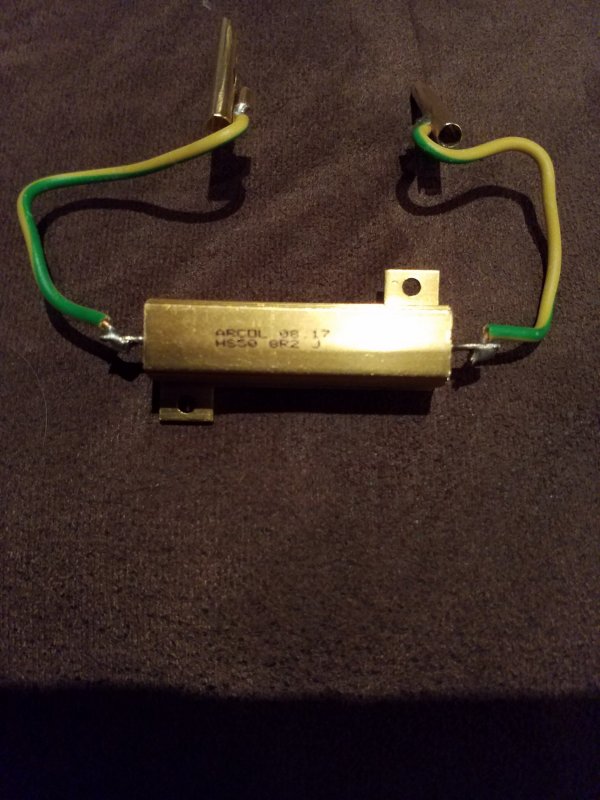
1khz 10 watt there are many who perform similarly most old school ampsAnd what is the frequency and output level. The square wave looks a bit too perfect for this kind of amp.
Thanks. This makes sense in the context of the video.1khz 10 watt there are many who perform similarly most old school amps
Similar threads
- Replies
- 16
- Views
- 2K
- Replies
- 4
- Views
- 937
- Replies
- 0
- Views
- 633
- Replies
- 15
- Views
- 1K
| Steve Williams Site Founder | Site Owner | Administrator | Ron Resnick Site Owner | Administrator | Julian (The Fixer) Website Build | Marketing Managersing |
















